Students can Download 1st PUC Biology Model Question Paper 4 with Answers, Karnataka 1st PUC Biology Model Question Papers with Answers helps you to revise the complete Karnataka State Board Syllabus and score more marks in your examinations.
Karnataka 1st PUC Biology Model Question Paper 4 with Answers
Time: 3.15 Hours
Max Marks: 70
General Instructions:
- The question paper consists of four parts A, B, C and D.
- All the parts are compulsory.
- Draw diagrams wherever necessary. Unlabelled diagrams or illustration do not attract any marks.
Part – A
Answer the following questions in one word / one sentence each: ( 10 × 1 = 10 )
Question 1.
Define genus.
Answer:
Genus is a group of related species which has more common characters in comparison to species of other genera.
Question 2.
What are adventitious roots?
Answer:
The roots developed from other than radicle parts.
Question 3.
Name the living mechanical tissue in plants.
Answer:
Collenchyma.
![]()
Question 4.
What do you mean by metacentric chromosome?
Answer:
The metacentric chromosome has middle centromere forming two equal arms.
Question 5.
Define crossing over.
Answer:
Exchange of genetic material between two non-sister chromatids of homologous chromosomes during prophase I of meiosis I.
Question 6.
What is a parthenocarpic fruit?
Answer:
It is the fruit formed without fertilization of the ovary.
Question 7.
What is plasmolysis?
Answer:
When a plant cell kept in hypertonic solution the water moves out of the cell as a result cell membrane (protoplast) shrinks is called plasmolysis.
Question 8.
Write the dental formula of man.
Answer:
2123/2123
Question 9.
What is ammonification?
Answer:
Decomposition of organic nitrogen of dead plants and animals into ammonia is called ammonification.
![]()
Question 10.
Expand ECG.
Answer:
Electrocardiograph.
Part – B
Answer any FIVE of the following questions in 3 -5 sentence each wherever applicable. ( 5 × 2 = 10 )
Question 11.
Write the difference between virus and viroids.
Answer:
| Virus | Viroids |
| 1. It is composed of nucleic acid and protein. | 1. It is composed of only RNA |
| 2. Infects both animals and plants. | 2. Infects only plants. |
| 3. These have high molecular weight. | 3. These have low molecular weight. |
Question 12.
What are acoelomates? Give one example.
Answer:
The animals in which body cavity is absent are called acoelomates.
Example: Tapeworm, Liver fluke.
![]()
Question 13.
Name the four whorls of flower.
Answer:
The four whorls are -calyx, corolla, androecium and gynoecium.
Question 14.
Differentiate the skeletal muscle from smooth muscle.
Answer:
| Skeletal muscle | Smooth muscle |
| 1. The muscles are attached to bone | 1. The muscles are present around blood vessels, inner wall of stomach and intestine. |
| 2. Alternative dark and light bands present | 2. Dark and light bands absent. |
| 3. Elongated with cylindrical in shape. | 3. Elongated with pointed ends. |
| 4. Cells are multi nucleated. | 4. Cells are uni-nucleated. |
| 5. Voluntary in function. | 5. Involuntary in function. |
Question 15.
Sketch and label the structure of chromosome.
Answer:
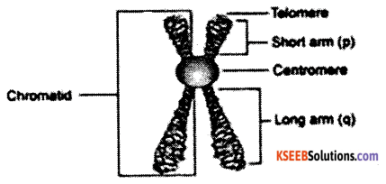
Question 16.
Write any two practical applications of ethylene.
Answer:
- It helps in ripening of fruits.
- It promotes senescence and abscission of plant organs.
- It breaks seed and bud dormancy.
- It initiates germination in peanut seeds.
![]()
Question 17.
What are myofibrils? Name two important proteins present in myofibrils.
Answer:
- Parallaly arranged filaments in the sarcoplasm of the muscles are called myofibrils.
- The proteins are Actin and Myosin.
Question 18.
List the functions of HCl indigestion.
Answer:
- It helps to maintain acidic pH in the stomach.
- It converts inactive pepsinogen to pepsin and prorenin to rennin.
Part – C
Answer any FIVE of the following questions in 100-150 words each wherever applicable. ( 5 × 3 = 15 )
Question 19.
Write any three characteristics of living organisms.
Answer:
- Growth.
- Reproduction.
- metabolism Consciousness.
Question 20.
Briefly explain the events of mitotic prophase.
Answer:
- Chromosomal material condenses to form thick thread like structures called chromosomes.
- Centrioles move towards opposite poles.
- Nuclear membrane and nucleolus disappears.
- Assembling of mitotic spindles and microtubules.
![]()
Question 21.
Draw a neat labeled diagram of T.S. of Dicot leaf.
Answer:
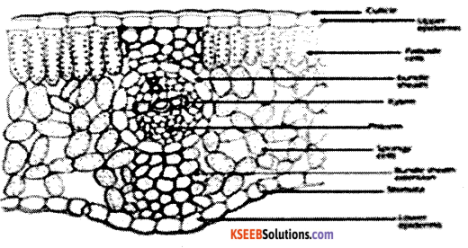
Question 22.
Define the following:
a) Differentiation
b) De-differentiation
c) Re-differentiation
Answer:
a) Differentiation – the cells derived from meristems and cambium differentiated to perform specific functions is known as differentiation.
b) De-differentiation – regaining the meristematic property in certain conditions by differentiated living tissue.
c) Re-differentiation – dedifferentiated tissue once again loose capacity to divide but mature to perform specific functions is known as Redifferentiation.
Question 23.
Give a brief account on respiratory disorders.
Answer:
Asthma – it is characterized by difficulty in breathing, causing wheezing due to inflammation of bronchi and bronchioles.
Emphysema- is a chronic disorder in which alveolar walls are damaged due to which respiratory surface is decreased.
Occupation respiratory disorders – long exposure to dust working in grinding or stone-breaking industries give rise to inflammation leading to fibrosis results in serious lung damage.
![]()
Question 24.
Explain the mechanism of blood clotting.
Answer:
- A clot or coagulation formed mainly of a network of threads called fibrins in which dead and damaged formed elements of blood are trapped.
- Fibrins are formed by the conversion of inactive fibrinogens in the plasma by the enzyme thrombin.
- Thrombin, in turn is formed from another inactive substance present in the plasma called prothrombin.
- An injury or a trauma stimulates the platelets in the blood to release certain factors which activate the mechanism of coagulation.
- Certain factors released by the tissues at the site of injury also can initiate coagulation.
- Calcium ions play a very important role in clotting.

Question 25.
Explain the process of ultra filtration.
Answer:
- The first step in urine formation is the filtration of blood, which is carried out by the glomerulus and is called glomerular filtration.
- On an average, 1100 – 1200 ml of blood is filtered by the kidneys per minute.
- The glomerular capillary blood pressure causes filtration of blood through 3 layers.
- The epithelial cells of Bowman’s capsule called podocytes are arranged in an intricate manner so as to leave some minute spaces called filtration slits.
- Blood is filtered so finely through these membranes onto the lumen of the Bowman’s capsule. Therefore, it is considered as a process of ultra filtration.
![]()
Question 26.
Mention three types of cellular movements in human body with an example.
Answer:
- Amoeboid movement: Macrophages, leucocytes and Cytoskeletal elements.
- Ciliary movement: Inner wall of trachea, female reproductive tract.
- Muscular movement: Limbs, jaws, tongue.
Part – D
Section – I
Answer any FOUR of the following questions in 200-250 words each wherever applicable. ( 4 × 5 = 20 )
Question 27.
Write the general characteristics of angiosperms.
Answer:
- They are flowering plants and most advanced and dominant plant of world.
- They include dicots and monocots.
- The male organ is Stamen. Which produces pollen grains; these germinate and produce male gametophyte.
- The female sex organ is pistil; it consists of stigma style and ovary. The egg is present in the embryo sac of the ovule.
- These exhibit double fertilization and triple fusion.
Question 28.
Enumerate the features of animals belongs to arthropods.
Answer:
- Arthropod animals have jointed legs.
- The body is covered by chitinous exoskeleton.
- Body is divisible into head, thorax and abdomen.
- Respiratory organs are gills, book gills, book lungs and tracheal system.
- Circulatory system is open type.
- Sensory organs are antennae, eyes, and statocyst.
- Excretion takes place through malphigian tubules.
![]()
Question 29.
Draw a neat labeled diagram of cockroach male reproductive system,.
Answer:
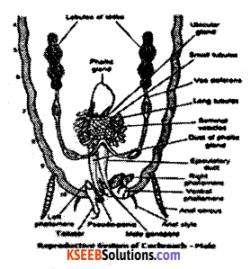
Question 30.
Describe the structure of chloroplast.
Answer:
- Chioroplast containing chlorophyll, caretenoids and helps in photosynthesis.
- Chioroplast is found in mesophyll tissue of leaves.
- They may be lens shaped, spherical, discoid and reticulate or ribbon like.
- It is covered by double membranes.
- The membrane encloses the stroma containing thylakoids in the grana.
- Stroma is liquid containing 70S ribosomes and enzymes and double stranded circular DNA.
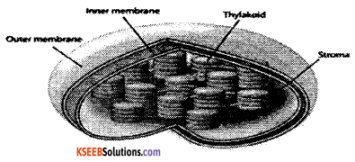
Question 31.
Name the building blocks of proteins and explain the structural aspects of proteins.
Answer:
- Amino acids.
- Primary structure: The amino acids molecules arranged in a linear chain with peptide bond. They exist like rigid rod.
- Secondary structure: In this organization the chain is folded. They are folded at right handed side.
- Tertiary structure: The protein chain folded one over the other form woolen ball, form three dimensional structure.
- Quaternary structure: The polypeptide chain arranged in the form of strings of sphere or may form cube.
![]()
Question 32.
Explain the pathway of water movement in root.
Answer:
- Apoplast pathway
- Symplast pathway.
Section – II
Answer any THREE of the following questions in 200-250 words each wherever applicable. ( 3 × 5 = 15 )
Question 33.
What are macro nutrients? Mention the role of any four macro nutrients.
Answer:
Definition: The elements required in large quantity (more than 10 m mol/ kg of dry matter) are called macro nutrients.
- Nitrogen:
- Phosphorus.
- Potassium
- Calcium.
- Magnesium.
![]()
Question 34.
Define law of limiting factor. Explain four external factors affecting the rate of photosynthesis.
Answer:
Definition: If a chemical process is affected by more than one factor, then its rate will be determined by the factor which is nearest to its minimal value: it is the factor which directly affects the process if its quantity is changed.
- Light
- Carbon dioxide
- Temperature
- Water
Question 35.
Write the schematic representation of Glycolysis.
Answer:
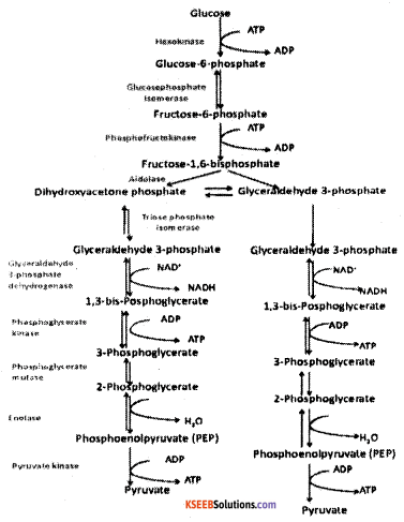
Question 36.
Draw a neat labeled diagram of sagital section of human brain.
Answer:
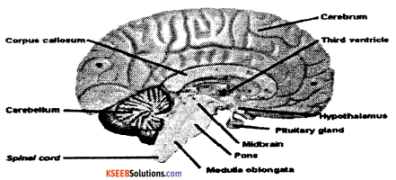
![]()
Question 37.
Name the hormones of adrenal gland and mention their functions.
Answer:
- Adrenaline: Stress hormone.
- Nor-adrenalinc: Stress hormone.
- Corticoids: Carbohydrate metabolism.
- Gluco-corticoids: Gluconeogenesis, lipolysis and proteolysis.
- Aldosterone: Reabsorption of Na+, Water, K+, Phosphate ions.